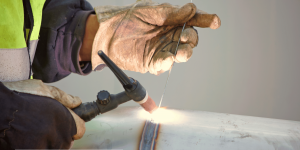Introduction
With regard to welding, it is essential to understand that there are few basic categories of the welding processes which are utilized and they include Arc welding, TIG welding and MIG welding. Hence, it is seen that each type of welding has its benefits and drawbacks depending on the position in which it is being used. The choice of weld type you should use depends on the type of metal to weld, thickness, appearance, expertise, and cost.
Arc Welding
What is Arc Welding
Arc welding utilizes an electrical arc, which produces heat to melt the metals to join them. An electric current is used to create an arc between the base metal and a consumable or non-consumable electrode. The electrode and base metal fuse, alloy, and solidify to form one material. Some of the widely used arc welding techniques are SMAW, FCAW & SAW, all described below.

Advantages of Arc Welding
– Affordable inputs and ease of operation
– Transportable for welding at other facilities
– It can weld both thick and thin metals
– It is compatible with many metal types such as mild steel, high carbon steel, cast iron, aluminium, copper, and nickel alloys
Disadvantages of Arc Welding
– This is a slow process that needs a highly skilled operator.
– Cleaning of spatter is always a challenge because it is splattered all over the place.
– The welds also have to be cleaned up by chipping off the slag deposits after welding.
Application of Arc Welding
Arc welding is suitable for welding heavily gauged sections, vertical up welding, and outdoor welding and welding in dirty conditions. Most commonly, it is employed in pipe welding, ship industry, construction, and car repair.
TIG Welding
What is TIG Welding
TIG welding is a welding method that employs a non-consumable tungsten electrode and an inert shielded gas to generate the arc for welding. The electrode, the weld puddle and the molten metal are shielded from being contaminated by an inert gas, argon or helium. In this process, the welder has to use his hands to insert a filler rod into the weld pool to add material.

Advantages of TIG Welding
– Aesthetic welds of high quality to ensure a clean appearance.
– Can weld thin metals that are less than 1 mm in thickness
– This process welds many materials like stainless steel, magnesium, copper alloys, and reactive metals.
– No slag or spatter to be cleaned
Disadvantages of TIG Welding
– Slower process and besides demands a high level of operator skills
– Higher cost of equipment and usage of shielded gases
– On thin metals unless filler rod is included
Best Applications of TIG Welding
TIG is most suitable for welding thin gauges of stainless steel and non-ferrous metals such as aluminium, magnesium and copper based alloys. It is commonly used in bicycle frames and forks, aircraft construction, auto customization, and artistic metal sculpture.
MIG Welding
What is MIG Welding
MIG (Metal Inert Gas) welding uses a continuous solid wire electrode fed through a welding gun into the weld pool. An inert shielding gas helps to minimize the chances of the weld metal being contaminated. These are the arc formations between the continuous wire electrode and base metal. The welder controls the welding gun while the wire feeder system automatically feeds the wire electrode.

Advantages of MIG Welding
– In addition to the position welding capacity
– It has higher deposition rates than TIG and stick welding.
– Safer to learn than stick or TIG welding
– Little weld cleaning is needed after the process
– MIG welds mild steel, stainless steel, aluminium, and other metals.
Disadvantages of MIG Welding
– Bigger amount spent in buying various equipment
– Low mobility in that the shielding gas has to be supplied externally.
– Challenging to forge when there is a risk of drafts
MIG welding is most suitable for the following applications:
MIG welding is perfect for home use, auto mechanics, small manufacturing shops, and fabrication. MIG is capable of welding thin sheet metal up to 3/4-inch-thick mild steel. It is the most frequently used process of joining materials in industrial applications today.
Conclusion
Thus, arc welding can be said to be most effective for thick sections of steel and welding under field conditions. TIG welding delivers the finest quality of welds on thin materials. TIG is the most rigid of the three, and MIG is relatively easier to do than TIG but is suitable for welding mild steel. It is, therefore, advisable to consult your local welding supply distributor to advise you on the right equipment for your welding projects. Training and safety equipment are crucial factors for anyone willing to begin any type of welding.
